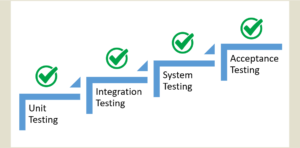Table of Contents
ToggleLevels of Software testing comprises four levels:
Unit Testing: Verifies whether software components fulfill their intended functionalities.
Integration Testing: Examines the flow of data between different modules.
System Testing: Assesses both functional and non-functional testing requirements.
Acceptance Testing: Ensures that the software meets the specified requirements outlined in a contract or specification upon delivery.

Unit Testing:
Unit testing involves examining the smallest testable portions of a system or application that can be compiled, linked, loaded, and executed. This testing method allows for the isolated testing of each module. The primary goal is to assess individual components separately, ensuring they fulfill their designated functionalities. Developers typically carry out this testing to verify the performance of each part of the software.
Integration Testing:
Integration testing revolves around the concept of combining different software modules. In this phase, these modules are amalgamated and tested as a group to ascertain the readiness of the integrated system for system testing. Integration testing specifically evaluates the flow of data from one module to another. Testers are responsible for conducting this type of testing to ensure the seamless integration of various components within the software.
System Testing:
System testing is executed on a fully integrated system to ensure its compliance with specified requirements. This comprehensive testing assesses the overall interaction of system components and includes examinations of load handling, performance, reliability, and security. System testing is often the concluding step to confirm that the system aligns with the specified criteria. It evaluates both functional and non-functional aspects to meet the testing needs.
Acceptance Testing:
Acceptance testing is a thorough examination conducted to verify if the software meets the requirements outlined in a specification or contract upon delivery. This type of testing is primarily carried out by the end user or customer, although other stakeholders may also be involved in the process. Acceptance testing ensures that the delivered software aligns with the expectations and criteria set forth in the specifications or contractual agreements.
